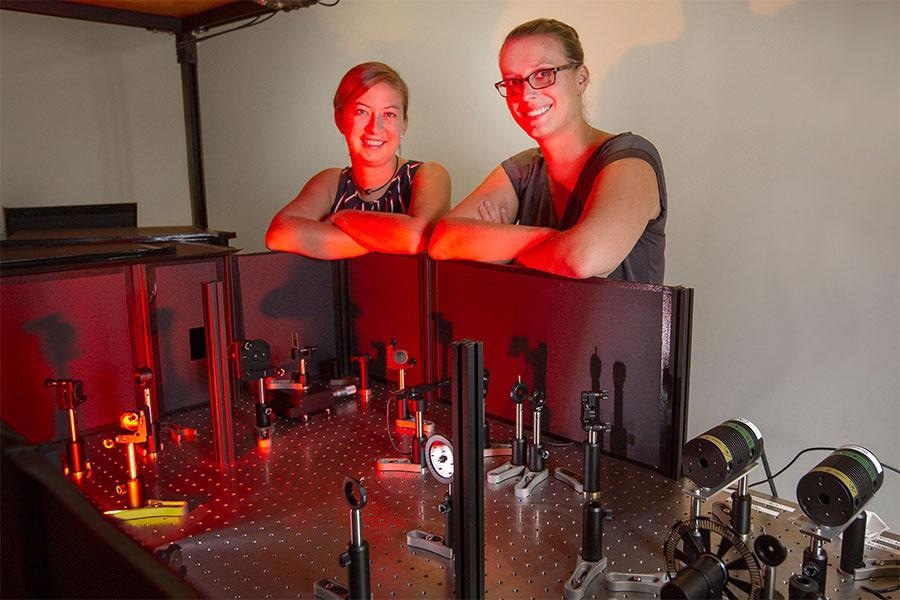A researcher at Florida State University is looking into a material that researchers around the globe are attempting to control to create better solar cells.
 Former Florida State University postdoctoral researcher Sarah Wieghold, left, and FSU Assistant Professor of Chemistry and Biochemistry Lea Nienhaus. Their research is helping to understand the fundamental processes in a material known as perovskites, work that could lead to more efficient solar cells that also do a better job of resisting degradation. Image Credit: Florida State University Photography Services.
Former Florida State University postdoctoral researcher Sarah Wieghold, left, and FSU Assistant Professor of Chemistry and Biochemistry Lea Nienhaus. Their research is helping to understand the fundamental processes in a material known as perovskites, work that could lead to more efficient solar cells that also do a better job of resisting degradation. Image Credit: Florida State University Photography Services.
In conjunction with Argonne National Laboratory, Assistant Professor Lea Nienhaus has released new research that looks at what occurs when this material, known as a halide perovskite, is exposed to real-world settings rather than the pristine conditions of a chemistry lab.
Scientists discovered that stressing halide perovskites by light and electric fields may alter the material’s fundamental characteristics and deform the lattice structure, which is critical for its stability.
All of this goes back to building a better solar cell. We needed to better understand what happens to this material when it is subjected to continuous illumination the way a solar cell would be if it were in use.
Lea Nienhaus, Assistant Professor, Chemistry and Biochemistry, Florida State University
The research is published in the journal ACS Energy Letters.
Over the last two decades, solar power technology has advanced significantly in the United States. Solar capacity has increased from 0.34 gigawatts in 2008 to 97.2 gigawatts now, according to the US Department of Energy.
However, scientists and engineers all over the world are still trying to develop better and more efficient materials to improve solar technology and make it more affordable and long-lasting.
Halide perovskites are considered to be one of the most promising solar materials. The crystal structure of lead halide perovskites is made up of a positively charged lead ion called a cation, an organic and/or inorganic cation, and negatively charged halide anions. These structures have been modified by Nienhaus and others to make films that might be used as the basis for solar cells.
The first perovskite solar cells were produced in 2006 and had a power conversion efficiency of 3%, while more subsequently developed ones have had efficiencies of 25% or more.
Although the significant rise in efficiency is encouraging, there are still some disadvantages to this material in terms of economic feasibility, such as the fact that it degrades rapidly.
While Nienhaus’ team was working on ways to enhance solar cells, Nienhaus and several of their research students began working on a side project to figure out why halide perovskite films deteriorate so quickly in real-world conditions.
Nienhaus and their research colleagues investigated surface characteristics and electrical properties of halide perovskites at the nanoscale scale using a method known as scanning tunneling microscopy. Researchers could observe how the material transformed under real-world conditions by adding a light source to the system.
Researchers also employed two synchrotron-based methods developed at Argonne National Laboratory’s Advanced Photon Source to link the observed optical alterations to structural changes in the halide perovskite film.
If we can pinpoint areas of structural change which are the origin of degradation, then we can start working on mitigation strategies that will ideally help us build a better halide perovskite film and thus a solar cell.
Lea Nienhaus, Assistant Professor, Chemistry and Biochemistry, Florida State University
Undergraduate Students Emily Cope and Gregory Moller of Florida State University, and Sarah Wieghold, Nozomi Shirato, Burak Guzelturk, and Volker Rose of Argonne National Laboratory, contributed to this research.
Journal Reference:
Wieghold, S., et al. (2022) Stressing Halide Perovskites with Light and Electric Fields. ACS Energy Letters. doi.org/10.1021/acsenergylett.2c00866.